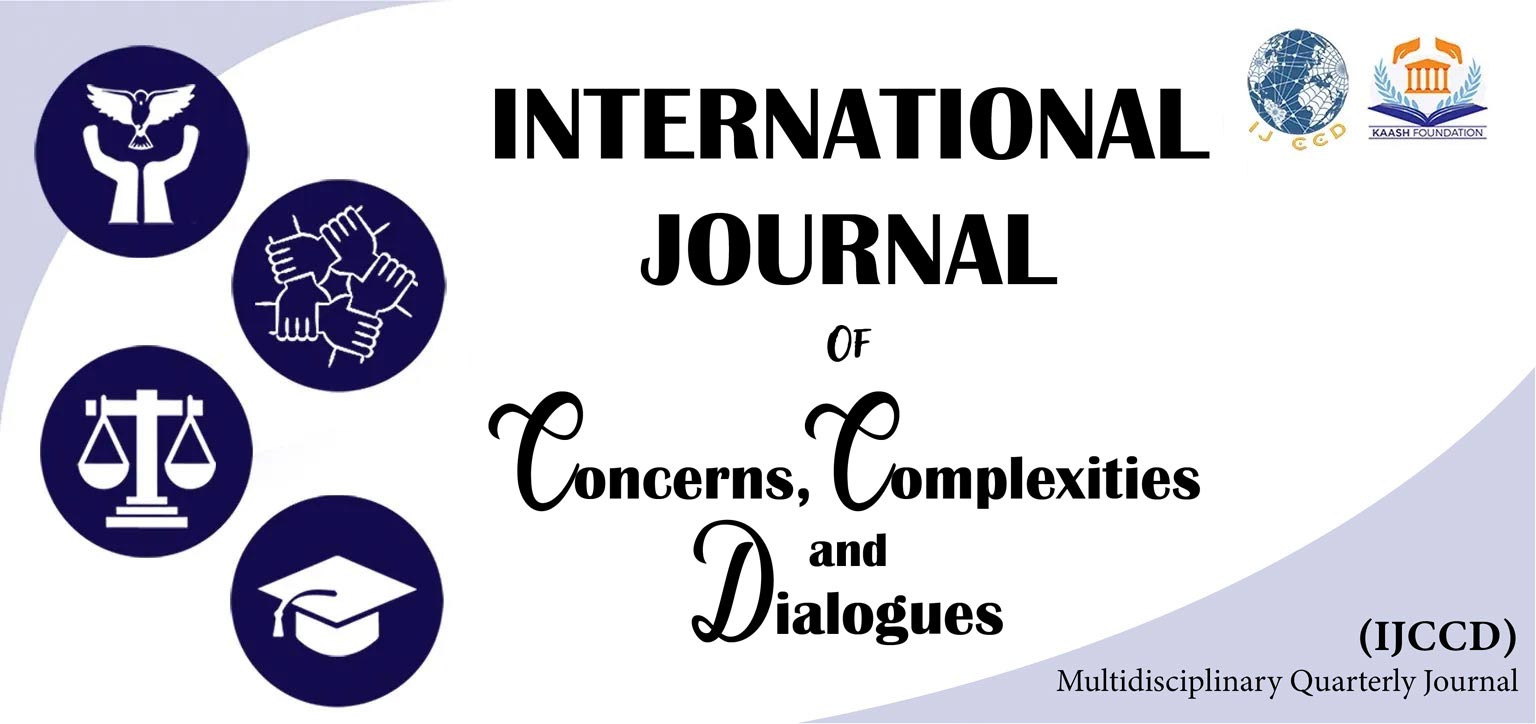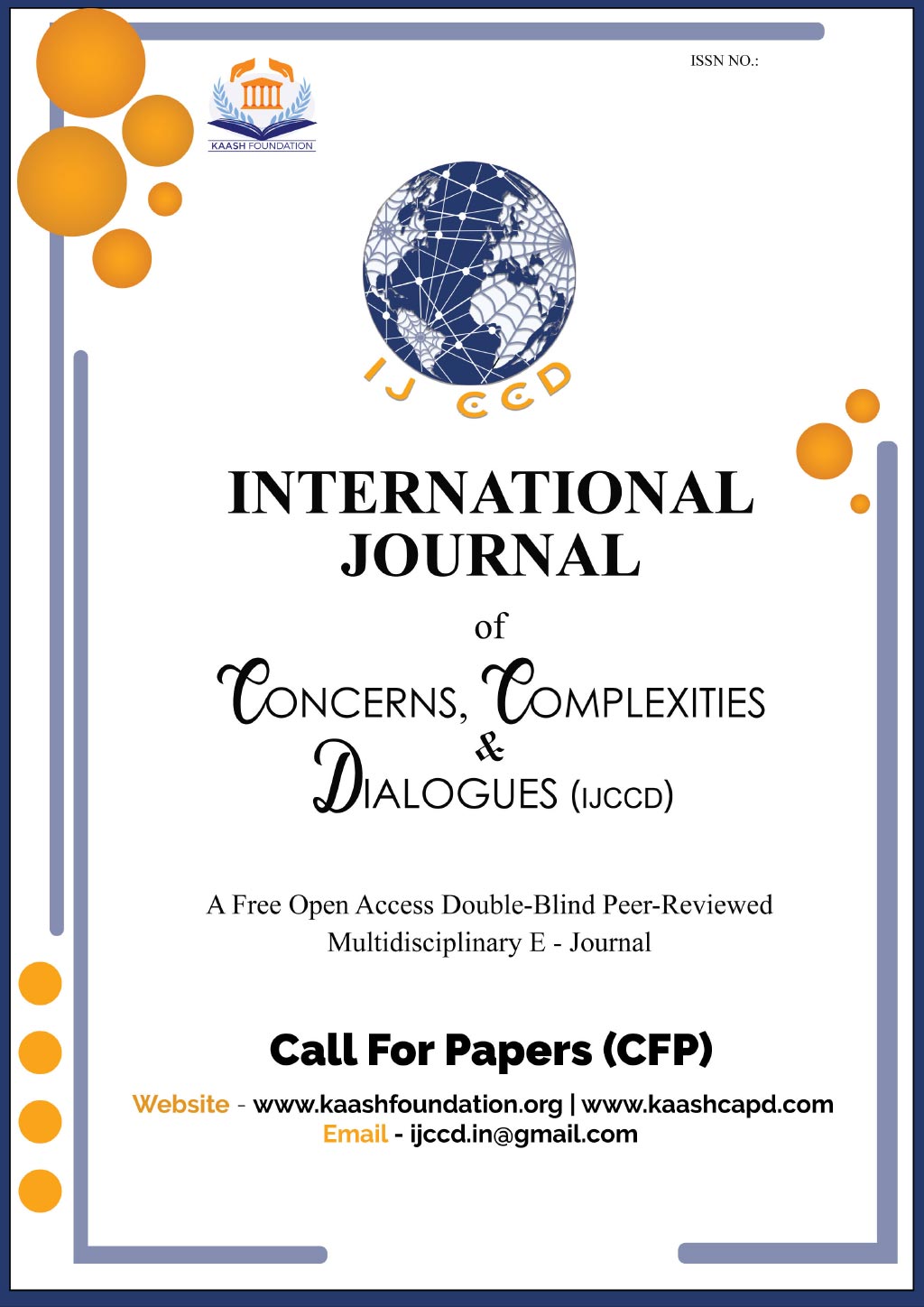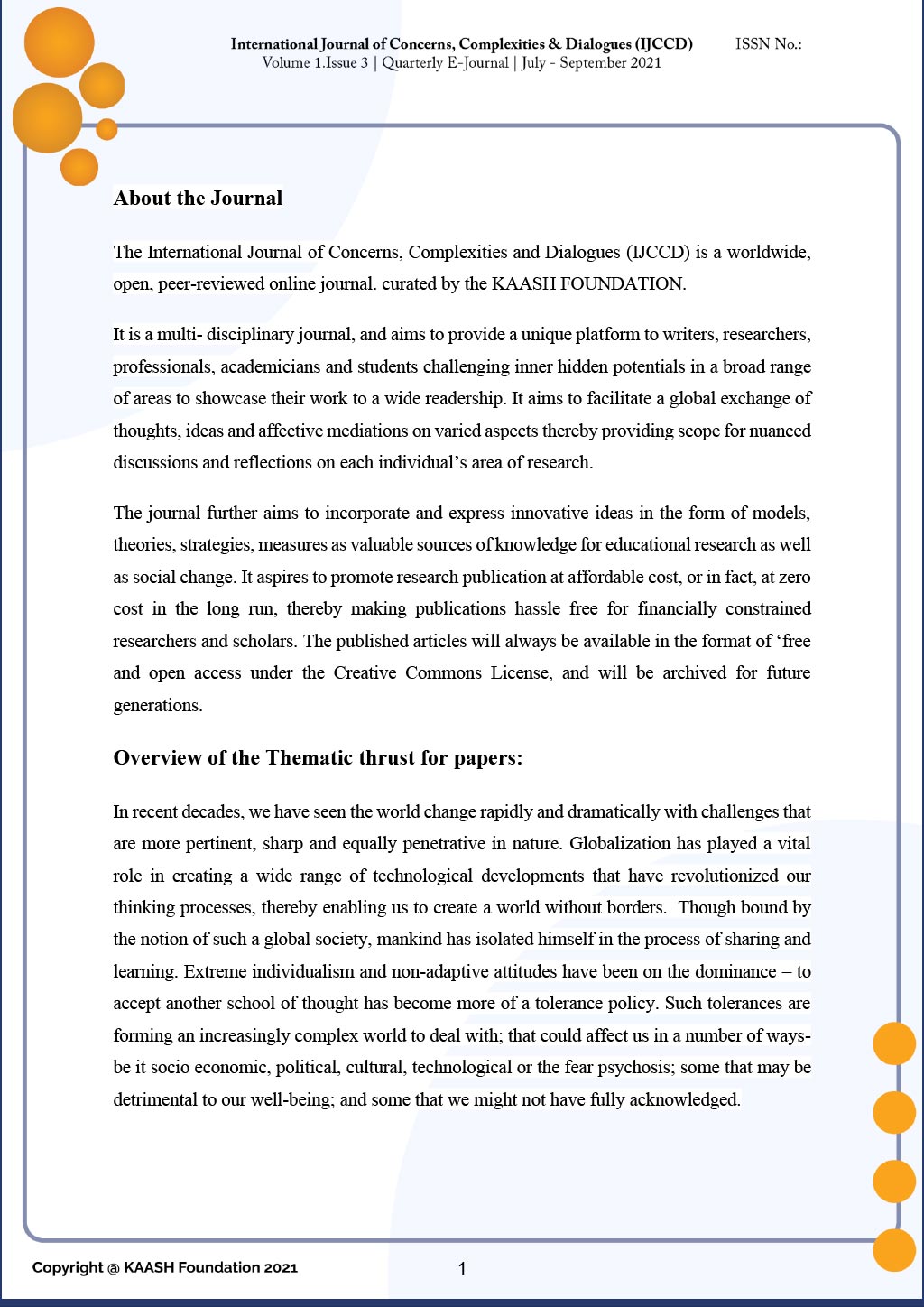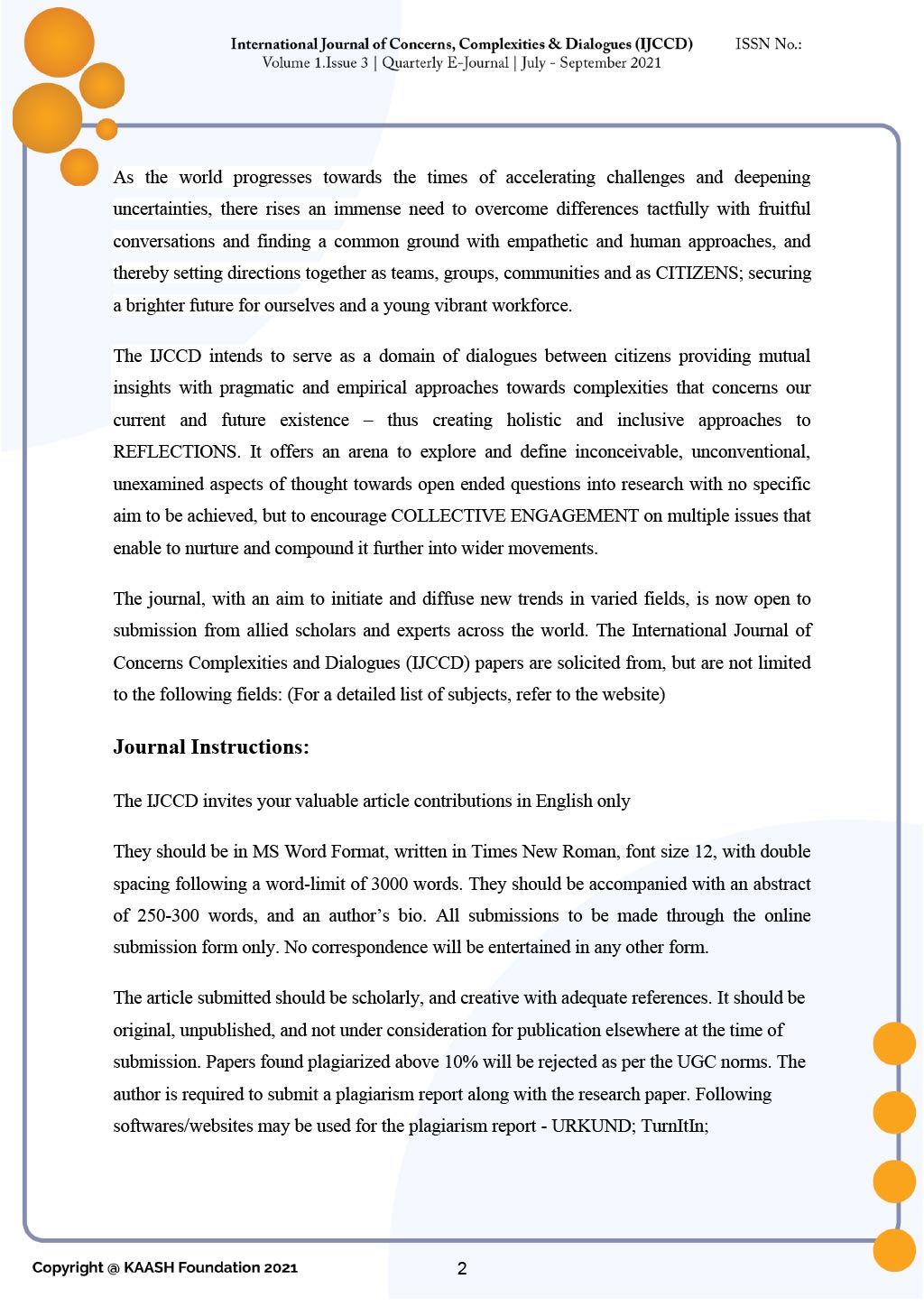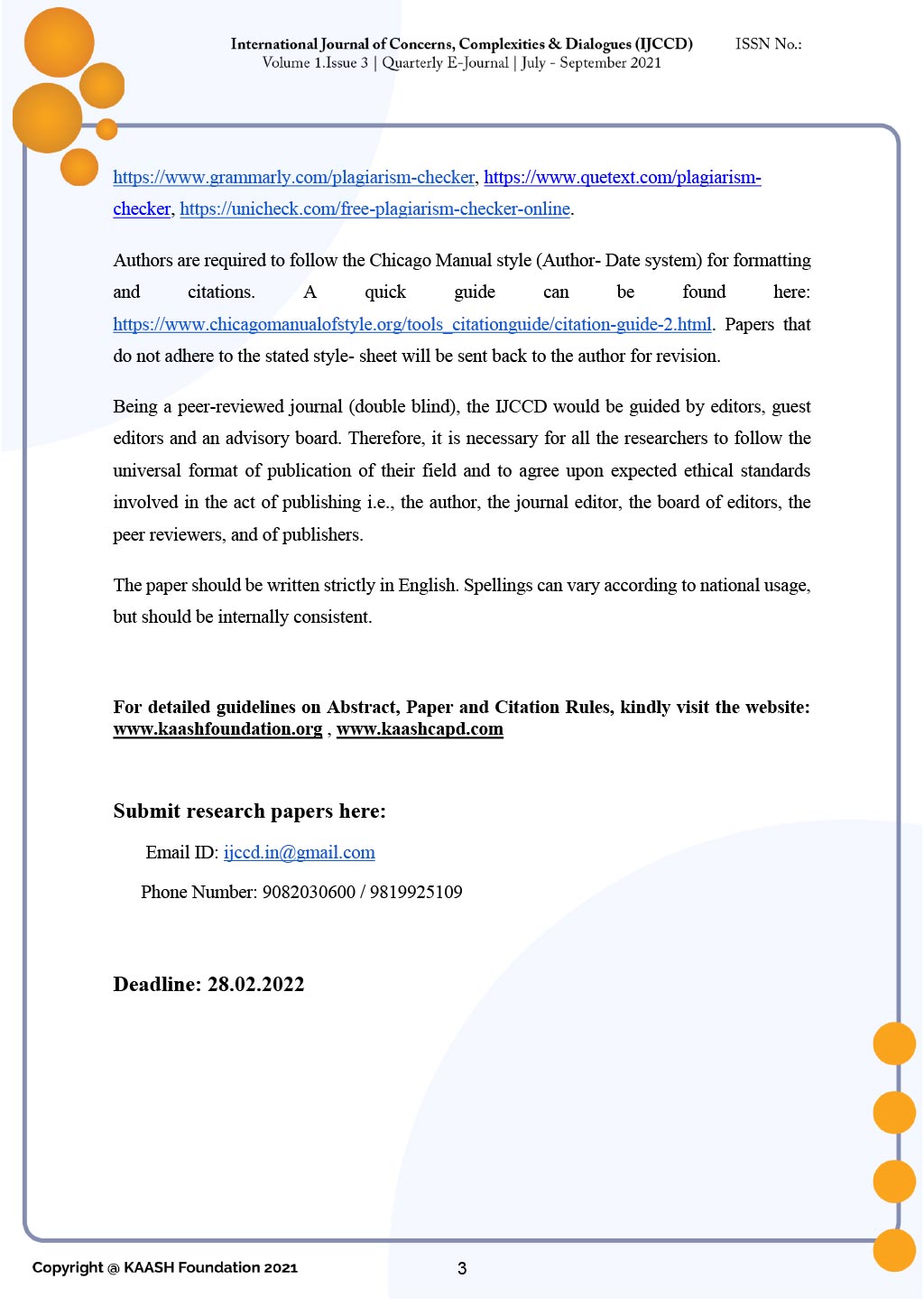Call for Papers : IJCCD
The journal provides a platform to express innovative ideas in the form of models, theories, strategies, measures etc. to be a valued knowledge resource for educational research and other interrelated institutions on national and global levels. It is to be a leading source of scholarly articles of research through promotion of research publication at affordable or at no cost in the long run – in turn making the publication hassle free for financially constrained researchers and scholars. The published articles will always be opened access, free under Creative, Commons License and archived for future generations. The journal with an aim to initiate and diffuse new trends in varied fields, is now open to submission from allied scholars and experts across the world.
The International Journal of Concerns, Complexities and Dialogues (IJCCD) is a worldwide, peer reviewed, online journal (double blind journal) curated by the KAASH foundation. It provides an exclusive platform for allied researchers and scholars to showcase their work that would facilitate a global exchange of thoughts and ideas.
The International Journal of Concerns, Complexities and Dialogues (IJCCD) papers are solicited from, but are not limited to the following fields:
- Science and Technology
- Mass communication and journalism
- Art and Design
- History and Social Sciences
- International relations and foreign affairs
- Human Resources
- Economics and Commerce
- Political Science, Law and public administration
- Banking, accounting and Finance
- Communication and Networking
- Business and Computing
- Linguistics/ Literature
- Psychology
- Philosophy
- Sociology and social work
- Marketing and management
- Anthropology
- Tourism and Hotel Management
- Biological and Agricultural Sciences
- Mathematical Sciences
- Healthcare and Medical Science
- Interdisciplinary/ Multi-disciplinary subjects
IJCCD invites your valuable article contributions submitted in English. The articles should be in MS Word Format, A4 paper size, follow the Times New Roman font size 12 with double spacing and a limit of approximately 3000 words. The article submitted should be original, scholarly, and creative with adequate references and not in consideration for publication elsewhere at the time of submission.
Being a Double-Blind Journal, the submitted articles would undergo a double peer review process with the guidance of editors, guest editors and an advisory board. Thereby, it is necessary for all participants i.e. the author, the journal editor, the board of editors, the peer reviewers and the publisher to follow the universal format of publication with ethical standards involved in the act of publishing.
Paper Guidelines:
To facilitate the submission process and the subsequent follow up the process, the following terms ad guidelines may be followed:
- All submission will be made through email only. No correspondence will be made in any other forms.
- All submitted research papers should contain original work neither published previously nor under consideration for publication elsewhere.
- Article found plagiarized above 20% excluding quotes will be rejected on the spot.
- An article should not be less than 3000 and not more than 10000 words.
- Once article is submitted, the copyright will be transferred to Editors. If article is rejected, then the copyright will rest back to the author itself.
- No queries pertaining to selection/rejection will be attained at any point.
- The decision of the editors will be final regarding acceptance/rejections of the articles that are going to be published.
- No author can claim back their article once it is submitted, therefore authors are strictly recommended to cross check their articles to debarred from any grammatical errors for which the editors will not be responsible at all.
- No author can claim any sort of relaxation and at any point editors reserve the right to cancel this notification without prior notice.
Authors are requested to follow the guidelines strictly, denouncement of which can result in the rejection of their article/s.:
- The author must necessarily present their results or conclusions as clearly and concisely as possible at the end of every article with proper foot notes, endnotes, references and bibliographies.
- Authors should ensure the accuracy of the quotes, charts, tables and maps
- They must refrain from including irrelevant images and graphics in the article. Images and graphics deemed irrelevant from evaluators to narrative understanding will be deleted. Images or graphics that have no direct impact in the article’s narrative but are useful to further understanding, can be uploaded as complementary files.
- Author is strictly advised to not to use images of any kind. At extreme situations they can use images for which they have sought copyright permission.
- Two or More Authors are allowed for writing one paper. However, the details of the Co-Author/s have to be mentioned in the format mentioned in Technicality along with the name of the Principal Author.
- The acceptable word range for the abstract is 175 – 275 words.
- The abstracts which do not meet this word limit will be requested for revisions.
- The Abstract template should be downloaded and the format has to be followed carefully.
- Submissions are to be made in English only.
- A brief biography should be attached together with the abstract
We encourage you to send informative abstracts (complete abstract) which is a compendious summary of a paper’s substance including its background, purpose, methodology, results, and conclusion.
Once the abstract is prepared and submitted as per the above guidelines, the researcher will be acknowledged of the receipt of the abstract via an email within two – three working days.
Full Paper Submission
Notification of Selection
Double Peer Review
Plagiarism Check
Final Draft After Correction
Submission of Article
Publication Date of Article
Full Paper Review Process
The aim of IJCCD is facilitated with the support of numerous international and national academic institutions and scholars, as well as practitioners who contribute to our mission of knowledge transfer; implementing a collaborative approach towards academic research, empowering decision makers in the government & corporate sector, and promoting critically aware social policies.
The IJCCD is dedicated to guaranteeing a timely and fair review process with the international norms of a double-blind peer review with the support of highly qualified professionals to assist with this endeavor. The process is elaborated as follows:
- All submitted research papers will go through a plagiarism test.
- Each paper will be reviewed by at least two reviewers. Editor-in-Chief / Editor/s / Associate Editor/s / Academic Editor/s as Heads of the IJCCD Committee will make the final decision on the papers.
- Every paper will undergo a double-blind peer review by an IJCCD constituted Committee Member within a week after its receipt.
- Results of the paper review will be sent to the author within two weeks of submission (Conditions apply if there is an emergency).
- Notices of acceptance of the papers will be sent to the author with reviewer comments.
- If revisions are required according to the reviewer comments, the revised abstract must be sent back within a week.
- If the paper is accepted, the candidate will be invited to send the entire research paper.
ABSTRACT ASSESSMENT CRITERIA
The Editorial Board evaluates the abstracts of the research as per the following criteria:
- Aims/objectives clearly stated
- Relevance to the paper
- Structure of the paper
- Clarity of language
- Appropriateness of the research/study/ methodology
- Discussion and conclusion
ETHICS AND RESPONSIBILITIES OF THE EDITORIAL BOARD ACCORDING TO COPE:
The Editorial board has developed a Code of Ethics based on Publication Ethics for it’s own editorial members. All the editorial board members have agreed to adhere on following ethics and responsibilities.
Contribution of Authors:
Reviewers will assist the authors through their feedback and comments by providing fair, honest, and unbiased assessment of the strengths and weaknesses of the abstracts/manuscript and provide objective and constructive feedback in review to encourage the authors to develop their research papers.
Conflict of Interest and Bias:
Reviewers should ensure to declare all potential competing, or conflicting interests. If the reviewers are unsure about a potential competing interest that may prevent him/her from reviewing, they would communicate this to the organizing committee as soon as possible. Reviewers will remain unbiased throughout the review process with regard to nationality, religious or political beliefs, gender, and other characteristics of the authors, origins of a manuscript and/or their professional affiliation.
Timeliness:
Reviewers should inform the editors if the manuscript cannot be reviewed as per the time given for the review until it is too late.
Confidentiality:
They would respect the confidentiality of the peer review process and refrain from using information obtained during the peer review process for their own or another’s advantage, or to disadvantage or discredit others.
Accountability:
They would not delegate the authority to any other person with regards to reviewing the research papers without obtaining permission of journal editors/IJCCD committee. Reviews of the research Papers and abstracts should also be prepared by the reviewer.
To facilitate the submission process and the subsequent follow up the process, please consider the following guidelines, information, tips, terms, and deadlines mentioned.
Paper Guidelines Structure
- All submission will be made through submission form only. No correspondence will be made in any other forms.
- All submitted research papers should contain original work neither published previously nor under consideration for publication elsewhere.
- Article found Plagiarized above 20%will be rejected on the spot as per UGC norms.
- An article should not be less than 2000 and not more than 4000
- Once article is submitted, the copyright will be transferred to IJCCD editorial board. If an article is rejected, the copyright will rest back to the author.
- No queries pertaining to selection/rejection will be entertained at any point.
- The paper template should be downloaded and the format should be followed carefully.
- Submission should be in English only.
- The decision of the editors will be final regarding acceptance/rejections of the articles that are going to be published.
- No author can claim back their article once they have submitted, therefore authors are strictly recommended to cross check their articles to debar from any grammatical errors for which the editors will not be responsible at all.
- No author can claim any sort of relaxation and at any point editors reserves right to cancel this notification without prior notifications.
- Format for Paper-Language- Font- referencing Style
File Format: Author should submit the paper only in the MS-word 2003 or a later format. If equations are used, they should be converted by using MS Office equation editor and pasted as image at proper place. All equations should be grouped or may be prepared using equation editor software.
- The length of the research papers should be 1500- 4000 words and must be written as a continuous (book style) narrative, not as a bullet list.
- The research paper should not include the name of the authors, nor the institution for which they work, nor their biographies.
- The research paper should be written using Times New Roman, Size 11p, single space.
- Graphics and images should be clear and easy to see. (We cannot improve the quality of images.)
- All images, graphics and tables must be accompanied by a title and a source; and should be placed where they will appear in the text.
- Using advanced functions of Word should be avoided for instance:
- a) Colored fonts and backgrounds.
b) Drawing objects
c) Automatic tables of contents and indexes.
d) Highlights, reliefs, shadows and other complex functions of Word.
Language: The paper should strictly be written in English; we are not processing papers in any other languages. Spelling can vary according to national usage, but should be internally consistent.
Font type & Sizes: Paper should be typed in double line spacing in Times New Roman with the following size pattern.
- a) For heading or title: 14 points and Bold (Small Letters, not capitalize the titles unnecessarily unless required)
- b) Author’s Name: 11 points and Bold
- c) For subtitles: 11 points and Bold
- d) Content of article: 10 points
- e) Table title and Content: 09 point
Referencing Style: (Guidelines)
The references in the text must follow an abbreviated format (Author, Year: pp.). The full reference list shall appear at the end of the article. Footnotes will be used to clarify or expand some explanations. They shall be numbered consecutively in Arabic numerals, letter of 8p. size and full justification. Efforts should be made to minimize the number of footnotes.
Whenever possible, include the DOI for each article in the bibliographic list, and indicate the URL if the cited Word is open access. The citation style chosen by this journal is the Chicago Manual Citation Style.
The list of references should appear at the end, letter size 10p., single-space, with no blank lines between authors. References should follow the following formats:
BOOK
Reference (hanging indent) for book:
Ward, Geoffrey C., and Ken Burns. The War: An Intimate History of the Second World War, 1941–1945.New York: Knopf, 2007.
First note (indented):
Geoffrey C. Ward and Ken Burns, The War: An Intimate History, 1941–1945 (New York: Knopf, 2007), 52.
Ibid or subsequent note (indented):
Ward and Burns, War, 59–61.
For four or more authors, list all of the authors in the bibliography; in the note, list only the first author, followed by et al. (“and others”) as in this example:
Reference (hanging indent) for book chapter:
Kelly, John D, et al. “Seeing Red: Mao Fetishism, Pax Americana, and the Moral Economy of War.” In Anthropology and Global Counterinsurgency, edited by John D. Kelly, John Marshall, Abigial Adamas, Josepgone Tey, and Mickey Spillane, 67–83. Chicago: University of Chicago Press, 2010.
First note (indented):
John D. Kelly, et al, “Seeing Red: Mao Fetishism, Pax Americana, and the Moral Economy of War,” in Anthropology and Global Counterinsurgency, ed. John D. Kelly, et al. (Chicago: University of Chicago Press, 2010), 77.
Ibid or subsequent note (indented):
Kelly, “Seeing Red,” 81–82.
BOOK PUBLISHED ELECTRONICALLY
If available in more than one format, cite the version. For online books, list URL; include an access date only if one is required by your discipline. If no fixed page numbers are available, include a section title or chapter or other number.
Reference (hanging indent) for e-book:
Austen, Jane. Pride and Prejudice. New York: Penguin Classics, 2007. Kindle edition.
First note (indented):
Jane Austen, Pride and Prejudice (New York: Penguin Classics, 2007), Kindle edition.
Ibid or subsequent note (indented):
Austen, Pride and Prejudice.
Reference (hanging indent) for web e-version:
Kurland, Philip B., and Ralph Lerner, eds. The Founders’ Constitution. Chicago: University of Chicago Press, 1987. Accessed February 28, 2010. http://press-pubs.uchicago.edu/founders/.
First note (indented):
Philip B. Kurland and Ralph Lerner, eds., The Founders’ Constitution (Chicago: University of Chicago Press, 1987), accessed February 28, 2010, http://press-pubs.uchicago.edu/founders/.
Ibid or subsequent note (indented):
Kurland and Lerner, Founder’s Constitution, chap. 10, doc. 19.
JOURNAL ARTICLE: Article in a print journal
In the bibliography, list the page range for the whole article. In a note, list the specific page numbers as consulted.
Reference (hanging indent):
Weinstein, Joshua I. “The Market in Plato’s Republic.” New Republic 104 (2009): 439–58.
First note intented:
Joshua I. Weinstein, “The Market in Plato’s Republic,” Classical Philology
104 (2009): 440.
Ibid or subsequent note (indented):
Weinstein, “Plato’s Republic,” 452–53.
Article in an online journal
Include a DOI if the journal lists one. A DOI is a permanent ID that, when appended to http://dx.doi.org/ in the address bar of an Internet browser, will lead to the source. If no DOI is available, list a URL. Include an access date only if one is required by your discipline.
Reference (hanging indent):
Kossinets, Gueorgi, and Duncan J. Watts. “Origins of Homophily in an Evolving Social Network.”
American Journal of Sociology 115 (2009): 405–50. doi:10.1086/599247.
First note (indented):
Gueorgi Kossinets and Duncan J. Watts, “Origins of Homophily in an Evolving Social Network,”
American Journal of Sociology 115 (2009): 411, doi:10.1086/599247.
Ibid or subsequent note (indented):
Kossinets and Watts, “Origins of Homophily,” 439.
Article in a newspaper or popular magazine
Newspaper and magazine articles may be cited in running text (“As Sheryl Stolberg and Robert Pear noted in a New York Times article on February 27, 2010…”); they are commonly omitted from a reference list. The following examples show the more formal versions of citations. If you consulted the article online, include a URL; include an access date only if your discipline requires one. If no author is identified, begin the citation with the article title.
Bibliography (hanging indent):
Stolberg, Sheryl Gay, and Robert Pear. “Wary Centrists Posing Challenge in Health Care Vote.” New York Times, February 27, 2010. http://www.nytimes.com/28/us/28health.html.
First note (indented):
Sheryl Gay Stolberg and Robert Pear, “Wary Centrists Posing Challenge in Health Care Vote,”
New York Times, February 27, 2010, http://www.nytimes.com//02/28/us/lth.html.
Ibid or subsequent note (indented):
Stolberg and Pear, “Wary Centrists.”
WEBSITE
A citation to website content can often be limited to a mention in the text or in a note (“As of July 19, 2008, the McDonald’s Corporation listed on its website . . .”). If a more formal citation is desired, it may be cited as in the examples below. Because such content is subject to change, include an access date or, if available, a date that the site was last modified.
Bibliography (hanging indent):
Google. “Google Privacy Policy.” Accessed July 19, 2010. http://www.google.com/intl/en/privacypolicy.html.
First note (indented):
“Google Privacy Policy,” last modified March 11, 2009, http://www.google.com/intl/en/privacypolicy.html.
Ibid or subsequent note (indented):
“Google Privacy Policy.”
AUTHOR & DATE BIBLIOGRAPHY SYSTEM
The following examples illustrate citations using the author-date system. Each example of a reference list entry is accompanied by an example of a corresponding parenthetical citation in the text. For more details and many more examples, see chapter 15 of The Chicago Manual of Style.
BOOK
Reference List (hanging indent):
Pollan, Michael. 2006. The Omnivore’s Dilemma: A Natural History of How Eating Has Evolved. New York: Penguin.
In Text Cite:
(Pollan 2006, 99–100)
Reference List (hanging indent):
Ward, Geoffrey C., and Ken Burns. 2007. The War: An Intimate History, 1941–1945. New York: Knopf.
In Text Cite:
(Ward and Burns 2007, 52)
For four or more authors, list all of the authors in the reference list; in the text, list only the first author, followed by et al. (“and others”):
(Barnes et al. 2010, 847)
Reference List (hanging indent) book chapter:
Kelly, John D. 2010. “Seeing Red: Mao Fetishism, Pax Americana, and the Moral Economy of War.” In Anthropology and Global Counterinsurgency, edited by John D. Kelly, Beatrice Jauregui, Sean T. Mitchell, and Jeremy Walton, 67–83. Chicago: University of Chicago Press.
In Text Cite:
(Kelly 2010, 77)
Chapter of an edited volume originally published elsewhere (as in primary sources):
Reference List (hanging indent) book originally published elsewhere:
Cicero, Quintus Tullius. 1986. “Handbook on Canvassing for the Consulship.” In Rome: Late Republic and Principate, edited by Walter Emil Kaegi Jr. and Peter White. Vol. 2 of University of Chicago Readings in Western Civilization, edited by John Boyer and Julius Kirshner, 33–46. Chicago: University of Chicago Press. Originally published in Evelyn S. Shuckburgh, trans., The Letters of Cicero, vol. 1 (London: George Bell & Sons, 1908).
In Text Cite:
(Cicero 1986, 35)
BOOK PUBLISHED ELECTRONICALLY
If a book is available in more than one format, cite the version you consulted. For books consulted online, list a URL; include an access date only if one is required by your discipline. If no fixed page numbers are available, you can include a section title or a chapter or other number.
Reference List (hanging indent):
Austen, Jane. 2007. Pride and Prejudice: A Novel in Five Books. New York: Penguin Classics. Kindle edition.
In Text Cite:
(Austen 2007, 101)
Reference List (hanging indent):
Kurland, Philip B., and Ralph Lerner, eds. 1987. The Founders’ Constitution. Chicago: University of Chicago Press. http://press-pubs.uchicago.edu/founders/.
In Text Cite:
(Kurland and Lerner, chap. 10, doc. 19)
JOURNAL ARTICLES
Article in a print journal
In the text, list the specific page numbers consulted, if any. In the reference list entry, list the page range for the whole article.
Reference List (hanging indent):
Weinstein, Joshua I. 2009. “The Market in Plato’s Republic.” Classical Philology 104:439–58.
In text cite:
(Weinstein 2009, 440)
Article in an online journal
Include a DOI if the journal lists one. A DOI is a permanent ID that, when appended to http://dx.doi.org/ in the address bar of an Internet browser, will lead to the source. If no DOI is available, list a URL. Include an access date only if one is required by your discipline.
Reference List (hanging indent):
Kossinets, Gueorgi, and Duncan J. Watts. 2009. “Origins of Homophily in an Evolving Social Network.”
American Journal of Sociology 115:405–50. doi:10.1086/599247.
In text cite:
(Kossinets and Watts 2009, 411)
Article in a newspaper or popular magazine
Newspaper and magazine articles may be cited in running text (“As Sheryl Stolberg and Robert Pear noted in a New York Times article on February 27, 2010…”); they are commonly omitted from a reference list. The following examples show more formal versions of the citations. If you consulted the article online, include a URL; include an access date only if your discipline requires one. If no author is identified, begin the citation with the article title.
Reference List (hanging indent):
Mendelsohn, Daniel. 2010. “But Enough about Me.” New Yorker, January 25.
In text cite:
(Mendelsohn 2010, 68)
Reference List (hanging indent):
Stolberg, Sheryl Gay, and Robert Pear. 2010. “Wary Centrists Posing Challenge in Health Care Vote.” New York Times, February 27. http://www.nytimes.com/2010/02/28/us/politics/28health.html.
In text cite:
(Stolberg and Pear 2010, 12)
WEBSITE
A citation to website content can often be limited to a mention in the text (“As of July 19, 2008, the McDonald’s Corporation listed on its website . . .”). If a more formal citation is desired, it may be cited as in the examples below. Because such content is subject to change, include an access date or, if available, a date that the site was last modified. In the absence of a date of publication, use the access date or last-modified date as the basis of the citation.
Bibliography (hanging indent):
Google. 2009. “Google Privacy Policy.” Last modified March 11. http://www.google.com/intl/en/privacypolicy.html.
In text cite:
(Google 2009)
Reference List (hanging indent):
McDonald’s Corporation. 2008. “McDonald’s Happy Meal Toy Safety Facts.” http://www.mcdonalds.com/corp/about/factsheets.html.
In text cite:
(McDonald’s 2008)
Papers shall go through a double peer review process to adjudge their suitability and authenticity, for publication in the book. A confirmation about the acceptance of the article will be sent to e-mail address of the corresponding author. The researchers are supposed to check their e-mail account frequently, because they will be notified of important information about their paper through e-mail only.
The reviewers shall review the article as per:
- instructions to author
- special emphasis on spelling
- format of references in text and reference section
- methodology
- Citation of journals
- Summary and findings.
Editorial Quality:
The peer review process is rigorous in order to ensure the quality of the content published in the journal. We except the authors to revise their texts following the suggestions of the referees. If the authors do not perform such reviews and do not submit comments back, the research paper will be rejected.
Some research papers may be of excellent quality but might be poorly written in English. This may be the case for authors whose native language is not English. When we receive a negative review on communicative quality (from 0 to 10), we may ask the author to resubmit a new version of the article. We cannot help the authors to re-write the content.


